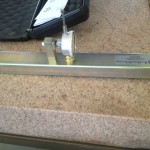New Height of Cut Gauge for Golf
A new height of cut gauge for golf is on the way. A few months ago John Patterson (Equipment Manager at PGA National) and I were talking about how inconsistent our height gauges were. He asked if I was seeing issues with the bars being straight right out of the box. This was something we had both seen for years. We both started talking and said why have we been so pushy on having things perfectly parallel and accurate but yet the one tool that is used to set the height of the machine we have accepted as flawed?
For many years now there has been only a few types of gauges to check the height of cut. We went from a bolt through a bar that was measured with a tape measure to get you close to an dial indicator gauge that was a single bar with a dial indicator to dial in the height. The only issue is that the bar 9 out of 10 times is not flat. If the bar is not flat well then your height of cut is not accurate. The other issue we have all dealt with is that if you set the height on a machine you were the one to set it on all machines because if you hold the bar slightly different it plays an effect on the HOC. All things we have just seemed to deal with over the years.
John and I talked and decided this was not good enough. So we called Mark Pilger at SIP Corporation (grinder manufacturer) and explained to him the situation and asked if he could help us come up with a gauge that would be accurate, allow multiple users to get repeatable results, and remain flat for years to come. Mark went to work and within a few weeks had a prototype designed. Last week I received my prototype gauge and love it.
The gauge is designed from 1/16″ mild steel tubing and is 18″ in length. The weight of the gauge is 3.7 lbs which is only slightly higher than a single bar heigh gauge. The square tubing doesn’t allow the bar to flex so even with 100’s of pounds of force your deviation is no more than .001. This is a far cry from the over .004 deviation you can get just by slightly pushing on a normal height gauge with a finger. The height gauge manufacturing process is: First the tube is cut, drilled, and the center indicator support tube is welded in. The welded assemblies are then sent out to be stress-relieved at a heat treating shop. After heat treating, the tubes are sent back to SIP for finish machining. The assemblies are sent out again to be plated with a yellow chromate finish After plating, the parts return once more to SIP for final assembly and inspection.
The gauge is still in prototype stage however is Patent Pending. Our next process is to select a few golf courses in which to try the gauges out and take in feedback before release. Our goal is to officially release the product at the Golf Industry Show in San Diego this February. The gauge will only be sold through the IGCEMA website and will be available to members and non members around the world. There will be a reduction in price for IGCEMA members. The height gauge will also have it’s own unique serial number and will come in a custom molded case.
This is an exciting time for me to be involved in the design of a tool that will help improve the industry and that is so much apart of what equipment technicians do on a daily basis.
You might also like
Continuing to Make a Difference
I have been asked over my career about many of the position choices I have made and how I chose them. I think career decisions are defined in many different
Communication – It’s our Fault!
Well it’s that time again for me to write yet another post about communication and how important it is to the success of our operations and our careers. In this
Automation of Equipment Sign out
Over the last 8-10 years I have been looking for an advanced way to figure out how to hold staff accountable for equipment damage, filling up with the wrong fuel




















1 Comment
Dan Stratton Crystal Downs CC
September 30, 11:41Looking for a cosistant gauge.Tired of changing batteries in digital gauge.Also hard to caliberate two different gauges.Am interested in becoming a member.